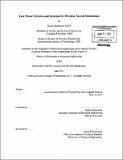| dc.contributor.advisor | Rahul Sarpeshkar. | en_US |
| dc.contributor.author | Arfin, Scott K. (Scott Kenneth) | en_US |
| dc.contributor.other | Massachusetts Institute of Technology. Dept. of Electrical Engineering and Computer Science. | en_US |
| dc.date.accessioned | 2011-09-27T18:30:39Z | |
| dc.date.available | 2011-09-27T18:30:39Z | |
| dc.date.copyright | 2011 | en_US |
| dc.date.issued | 2011 | en_US |
| dc.identifier.uri | http://hdl.handle.net/1721.1/65999 | |
| dc.description | Thesis (Ph. D.)--Massachusetts Institute of Technology, Dept. of Electrical Engineering and Computer Science, 2011. | en_US |
| dc.description | Cataloged from PDF version of thesis. | en_US |
| dc.description | Includes bibliographical references (p. 155-161). | en_US |
| dc.description.abstract | Electrical stimulation of tissues is an increasingly valuable tool for treating a variety of disorders, with applications including cardiac pacemakers, cochlear implants, visual prostheses, deep brain stimulators, spinal cord stimulators, and muscle stimulators. Brain implants for paralysis treatments are increasingly providing sensory feedback via neural stimulation. Within the field of neuroscience, the perturbation of neuronal circuits wirelessly in untethered, freely-behaving animals is of particular importance. In implantable systems, power consumption is often the limiting factor in determining battery or power coil size, cost, and level of tissue heating, with stimulation circuitry typically dominating the power budget of the entire implant. Thus, there is strong motivation to improve the energy efficiency of implantable electrical stimulators. In this thesis, I present two examples of low-power tissue stimulators. The first type is a wireless, low-power neural stimulation system for use in freely behaving animals. The system consists of an external transmitter and a miniature, implantable wireless receiver-and-stimulator utilizing a custom integrated chip built in a standard 0.5 ptm CMOS process. Low power design permits 12 days of continuous experimentation from a 5 mAh battery, extended by an automatic sleep mode that reduces standby power consumption by 2.5x. To test this device, bipolar stimulating electrodes were implanted into the songbird motor nucleus HVC of zebra finches. Single-neuron recordings revealed that wireless stimulation of HVC led to a strong increase of spiking activity in its downstream target, the robust nucleus of the arcopallium (RA). When this device was used to deliver biphasic pulses of current randomly during singing, singing activity was prematurely terminated in all birds tested. The second stimulator I present is a novel, energy-efficient electrode stimulator with feedback current regulation. This stimulator uses inductive storage and recycling of energy based on a dynamic power supply to drive an electrode in an adiabatic fashion such that energy consumption is minimized. Since there are no explicit current sources or current limiters, wasteful energy dissipation across such elements is naturally avoided. The stimulator also utilizes a shunt current-sensor to monitor and regulate the current through the electrode via feedback, thus enabling flexible and safe stimulation. The dynamic power supply allows efficient transfer of energy both to and from the electrode, and is based on a DC-DC converter topology that is used in a bidirectional fashion. In an exemplary electrode implementation, I show how the stimulator combines the efficiency of voltage control and the safety and accuracy of current control in a single low-power integrated-circuit built in a standard 0.35 pm CMOS process. I also perform a theoretical analysis of the energy efficiency that is in accord with experimental measurements. In its current proof-of-concept implementation, this stimulator achieves a 2x-3x reduction in energy consumption as compared to a conventional current-source-based stimulator operating from a fixed power supply. | en_US |
| dc.description.statementofresponsibility | by Scott Kenneth Arfin. | en_US |
| dc.format.extent | 161 p. | en_US |
| dc.language.iso | eng | en_US |
| dc.publisher | Massachusetts Institute of Technology | en_US |
| dc.rights | M.I.T. theses are protected by
copyright. They may be viewed from this source for any purpose, but
reproduction or distribution in any format is prohibited without written
permission. See provided URL for inquiries about permission. | en_US |
| dc.rights.uri | http://dspace.mit.edu/handle/1721.1/7582 | en_US |
| dc.subject | Electrical Engineering and Computer Science. | en_US |
| dc.title | Low power circuits and systems for wireless neural stimulation | en_US |
| dc.type | Thesis | en_US |
| dc.description.degree | Ph.D. | en_US |
| dc.contributor.department | Massachusetts Institute of Technology. Department of Electrical Engineering and Computer Science | |
| dc.identifier.oclc | 751489392 | en_US |
